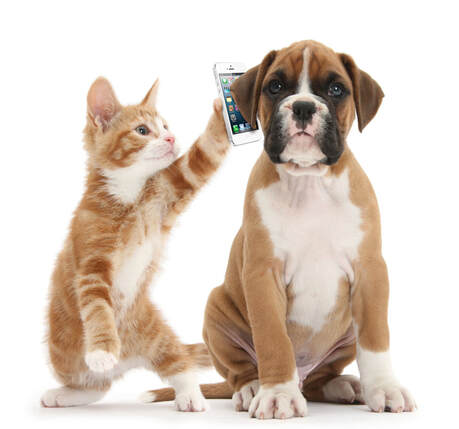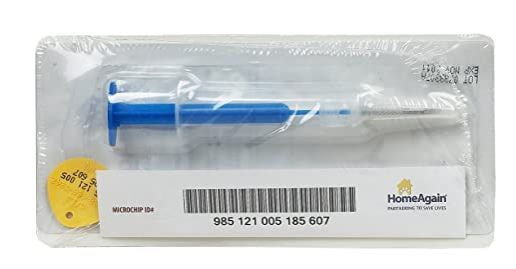|
It happens every day. Pets are displaced from caregivers for a variety of reasons and not all have to do with someone’s irresponsibility. A cat slips outside when a child leaves a door open. A dog escapes a fenced area when a contractor leaves a gate open. A cat is scared by loud noises or fireworks and runs from a yard in fear. A person is in a traffic accident and the dog traveling in the car with them runs off when a door is opened. Severe weather arrives quickly and pets go missing either before or after a storm. We try to do our best to make sure our companion animals are not separated from us, but sometimes our best is not enough. Most animals who get lost or go missing don’t make it back home for one reason: they cannot be identified. I see posts every day on social media about lost animals someone has found. Many people do the right thing and alert local animal control authorities to increase the chance of the caregiver being able to find their lost pet. Just as many people don’t take that step at all, instead choosing to either keep the found animal or give the animal away to someone else. I know people joke about what their pets would say if they could talk and while we know that won’t happen any time soon, it would certainly make it easier to get them back where they belong. “I got lost when I chased a squirrel and then another dog and then a cat. But I live at 123 Main Street. Can you give me a ride home?” There are many ways to help pets be identified if they are lost. A dog collar with a phone number. A collar with a tag what includes a name and phone number. As I have written about before, my go-to recommendation is to have a microchip in addition to these other methods because it cannot fall off, cannot be torn off and cannot be taken off by someone who finds your pet. Our dog wears a collar with his rabies tag, but it also has a tag with his name, on the back of which is his microchip number and the phone number of the manufacturer to call if he is found. A microchip is not a GPS tracker. It’s a small implant, about the size of a grain of rice, that functions using radio-frequency identification which does not require a power source. Think of it like a barcode for your pet. When a microchip scanner is passed over the pet, the microchip gets enough power from the scanner to send the microchip identification number to the scanner. That number is then used to trace the animal back to your registration for the chip. There is no battery, no moving parts, nothing to lose, nothing to charge and nothing to wear out. The microchip will last for the lifetime of your companion animal. Beyond the obvious simplicity of microchip, it has another advantage. If your pet is stolen, the chip is your “proof” that the animal belongs to you. All of this is dependent, of course, on registering the microchip with the manufacturer and keeping that registration information current whether you move or whether you have to re-home your pet yourself for some reason. Just this morning I saw a story on the news about the power of microchipping. A woman in Foley, Alabama, lost her dog more than two years ago. Brooke Lake opened the door of her house and her Beagle, Lilly, “caught a scent and she just ran.” Brooke did all the right things. She searched everywhere, called veterinary clinics, called animal shelters and still could not find Lilly. What Brooke did not know is that Lilly had found her way to a truck stop where someone picked her up and drove her to Oklahoma. Her new caregivers had trouble keeping Lilly inside their fenced yard and took her to an animal shelter. Lilly was scanned for a microchip and was traced back to Brooke. An Oklahoma rescue group will transport Lilly back to Foley this week to a very excited Brooke. This happy story would not be possible without Brooke having taken the time to have her dog microchipped. We hear stories like this often and as amazing as they are, they reinforce for us the fact that microchips work to get pets back home. So, where do you get a microchip and how much do they cost? It varies depending on where you live. If you got your companion animal from a shelter or rescue group, he or she may already be microchipped so check with that organization to get information from them first. Most veterinarians will microchip your pet although some charge a lot for that process. It’s often possible to get your pet chipped for a super low cost at a microchipping event in your area. You can also buy your own microchip and ask your veterinarian to implant it for you. I found a Home Again Microchip on Amazon for $13.75 and at Jeffers for $11.99. If your veterinarian will not insert a chip you purchase yourself to save money, it may be time to find a new veterinarian. Once the chip is implanted, make sure you register it and keep the registration information current. I also recommend having your veterinarian scan your pet’s microchip during regular exams to make sure the chip has not migrated to another part of your pet’s body. I also recommend you use a chip from a reputable company like Home Again, DataMars (Petlink), AKC Reunite, AVID or 24PetWatch. There are some really cheap chips which are part of a 900 shared manufacturer series (used globally) which are not as reliable.
I’ve had people tell me that they don’t think their pet needs to be microchipped because they live inside or are never without supervision outside. Considering how little a microchip costs, and the fact that our companion animals are priceless to us, I think all pets should be microchipped. We just never know what unexpected events may happen and once a pet is displaced from us, it is too late to lament the fact that we didn’t spend $20 to help them get back home. Microchipping is suitable for a variety of species we keep as animal companions. If your animals are not microchipped, please make plans to help them "call home."
1 Comment
|
AuthorI am an animal welfare advocate. My goal is to help people understand some basic issues related to companion animals in America. Awareness leads to education leads to action leads to change. Archives
July 2024
Categories
All
image courtesy of Terrah Johnson
|



 RSS Feed
RSS Feed